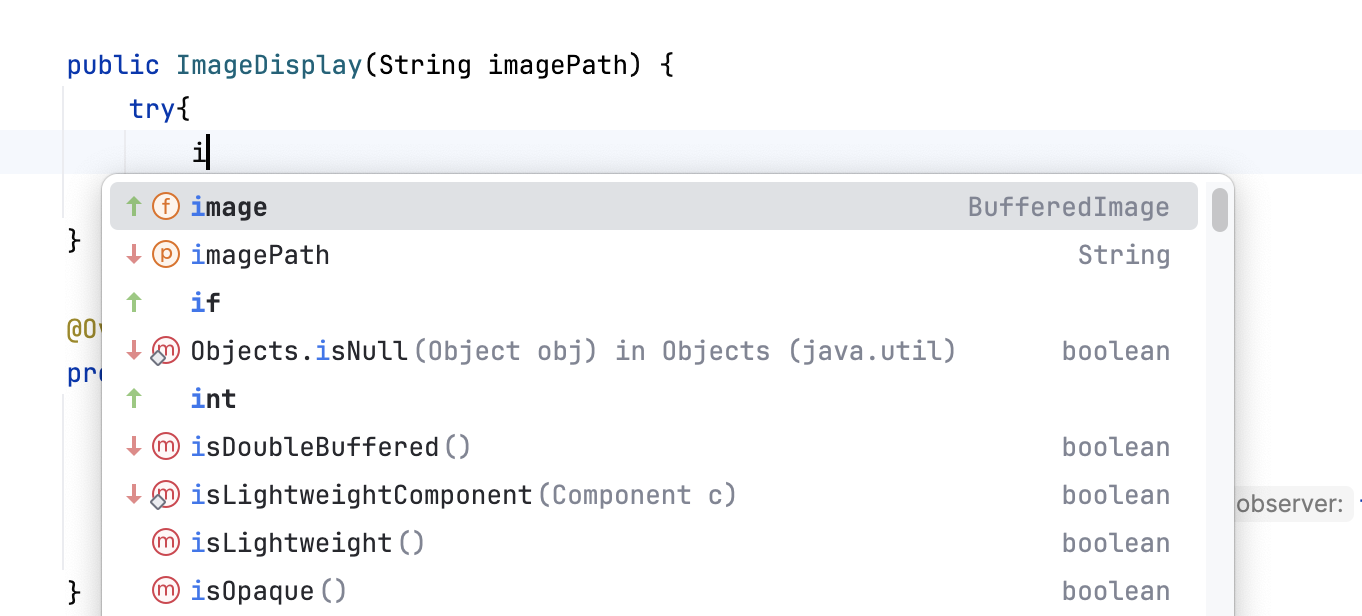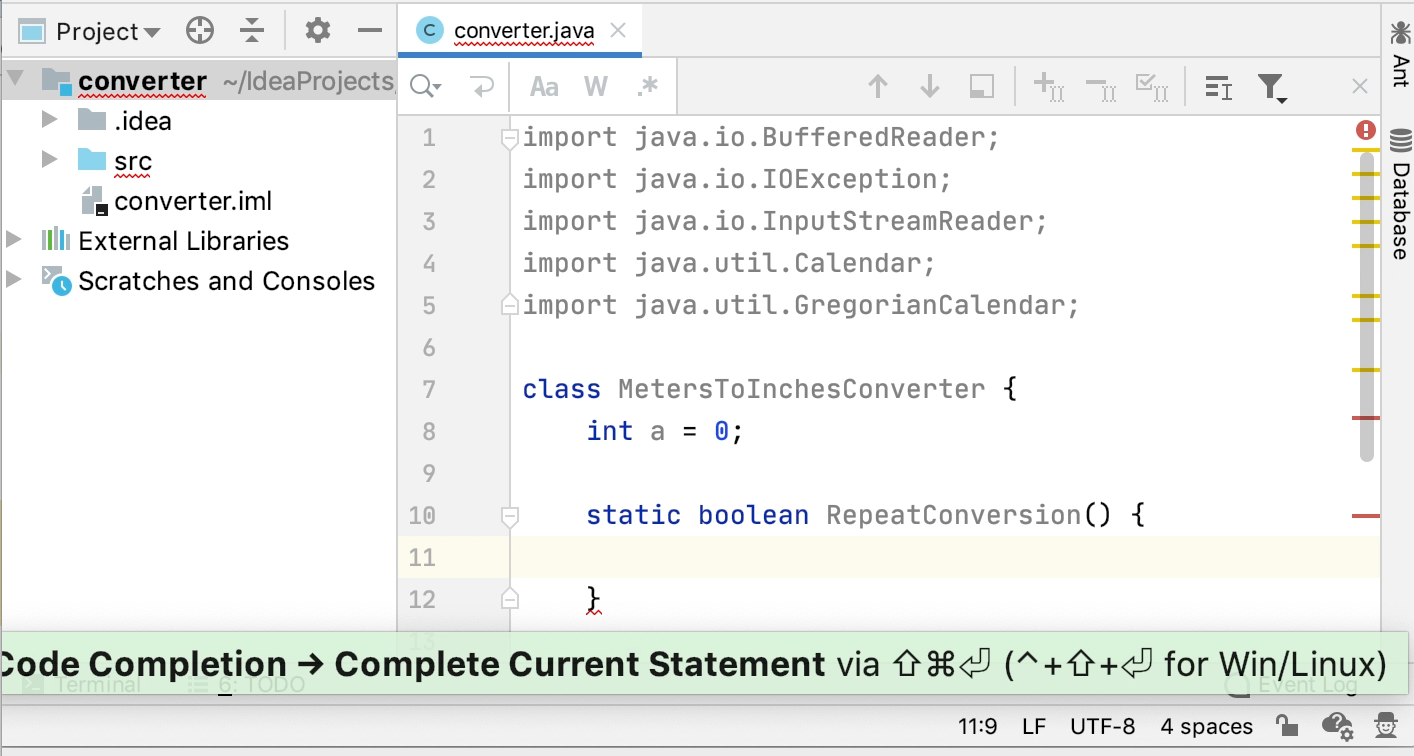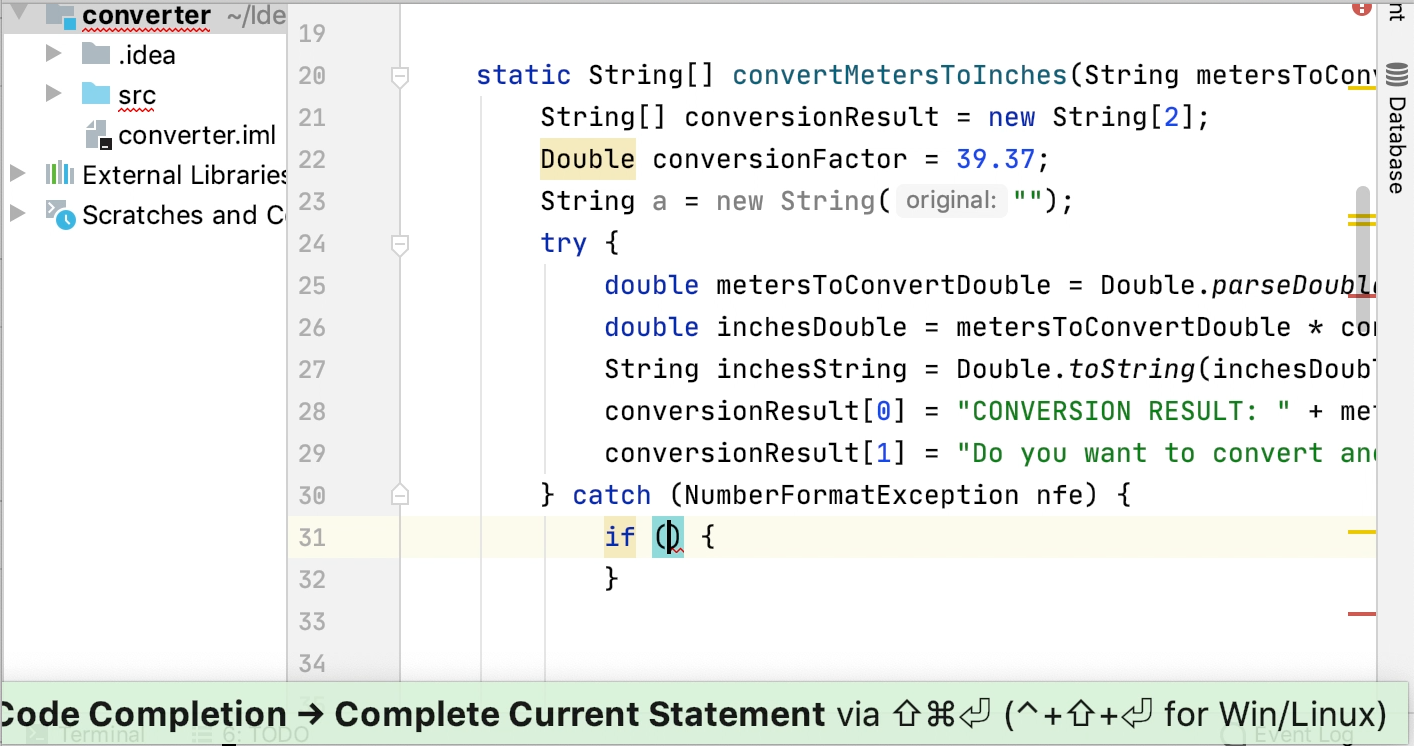Code completion
Configure: Settings (CtrlAlt0S) | Editor | General | Code Completion
For automatic completion, enable Show suggestions as you type.
Basic completion: CtrlSpace
To reject all suggestions, press Esc.
Basic code completion helps you complete the names of classes, methods, fields, and keywords within the visibility scope.
IntelliJ IDEA analyzes the context and suggests the choices that are reachable from the current caret position. Suggestions also include Live templates. Completion is available for a non-English keyboard layout.
By default, IntelliJ IDEA displays the code completion popup automatically as you type.
Alternatively, you can press CtrlSpace or select Code | Code Completion | Basic from the main menu.
Invoking code completion for the second time shows inaccessible classes and members (these can be made public by applying an intention action).
When invoked for the third time in a row, completion looks for suggestions for classes and interface names in the entire project, regardless of dependencies. If the necessary class is not yet imported, it will be imported automatically.
Code completion is available for custom file types. However, IntelliJ IDEA does not recognize the structure of such files and suggests options regardless of whether they are appropriate in the current context.
Press Enter or double-click the relevant list item to insert it to the left of the caret.
Press Tab to replace the characters to the right from the caret.
Use CtrlShiftEnter to make the current code construct syntactically correct (balance parentheses, add missing braces and semicolons, and so on).
Use specific keys and custom characters to accept the selected completion suggestion. To enable these features, go to the Editor | General | Code Completion settings page CtrlAlt0S and do the following:
To use specific keys, select the Insert selected suggestion by pressing space, dot, or other context-dependent keys checkbox. These keys depend on the language, your context, and so on. For Java, such keys include
Space, Tab,[and],(and), and some more.To also use custom characters, enter the characters into the Additional characters to accept the completion field.
note
While this setting helps you save time, turning it on may result in items being inserted accidentally.
tip
Completion in the Stream API chains is aware of type casts, so the list will not only contain items based on the existing call
filter(String.class::isInstance), but also automatically typecasted suggestions.
Press CtrlAlt0S to open settings and then select Editor | General | Auto Import.
Under Exclude from import and completion, add the names of classes or packages that you want to exclude from completion. The classes you specify here will not appear in the suggestion list.
You can also exclude items from the completion list: press AltEnter when the list with completion suggestions is open and select the item you want to exclude.
This feature allows you to import frequently used static methods automatically. When you type a method from a prioritized class, the IDE shows completion suggestions. Selecting a suggestion from the list inserts the corresponding import statement without requiring manual edits.
Press CtrlAlt0S to open settings and then select Editor | General | Auto Import.
In the Include auto-import of static members in completion section, click
or press AltInsert.
In the dialog that opens, specify the class you want to add to the list. You can search for the classes by name of select them from the project structure.
To the right from the class name, you can also select whether you want to prioritize it in the current project only or in all projects (globally).
Smart type-matching code completion filters the suggestion list and shows only the types applicable to the current context.
Type-matching completion is useful in situations when it is possible to determine the appropriate type:
In the right part of assignment statements
In variable initializers
In
returnstatementsIn the list of arguments of a method call
After the
newkeyword in an object declarationIn chained expressions
Start typing. By default, IntelliJ IDEA displays the code completion popup automatically as you type. If automatic completion is disabled, press CtrlShiftSpace or choose Code | Code Completion | Type-Matching from the main menu.

If necessary, press CtrlShiftSpace once again. This lets you complete:
Collections, lists and arrays. IntelliJ IDEA searches for symbols with the same component type and suggests converting them.
Static method calls or constant references. IntelliJ IDEA scans for static methods and fields and suggests the ones suitable in the current context.

note
Completion for chained expressions is only available for Java and requires the project to be built with the IntelliJ IDEA compiler (not the Gradle compiler).
You can create syntactically correct code constructs by using statement completion. It inserts the necessary syntax elements (parentheses, braces, and semicolons) and gets you in a position where you can start typing the next statement.
Hippie completion is a completion engine that analyses your text in the visible scope and generates suggestions from the current context. It helps you complete any word from any of the currently opened files.
Type the initial string and do one of the following:
Press Alt0/ or choose Code | Code Completion | Cyclic Expand Word to search for matching words before the caret.
Press AltShift0/ or choose Code | Code Completion | Cyclic Expand Word (Backward) to search for matching words after the caret and in other open files.
The first suggested value appears, and the prototype is highlighted in the source code.

Accept the suggestion or hold the Alt key and keep pressing 0\ until you find the word you need.
IntelliJ IDEA automatically completes names and values of tags and attributes in many file types:
HTML/XHTML, including completion for CSS classes and for HTML tags inside JSX.
tip
If Emmet support is enabled, Emmet templates are also completed automatically in the HTML and XML contexts.
XML/XSL
JSP/JSPX
GSP
JSON. For more information, refer to Editing package.json.
Completion of tags and attribute names is based on the DTD or Schema the file is associated with. If there is no schema association, IntelliJ IDEA will use the file content (tag and attribute names and their values) to complete your input.
In XML/XSL and JSP/JSPX files, completion for taglibs and namespaces is available.
Type the opening
<and then start typing the tag name. IntelliJ IDEA displays the list of tag names appropriate in the current context.
Use the 0↑ and 0↓ keys to scroll through the list.
Press Enter to accept a selection from the list. If your file is associated with a schema or a DTD, IntelliJ IDEA automatically inserts the mandatory attributes according to it.
If you need to use tags declared in a tag library, you need to import this taglib before any custom tag from it can be used.
Start typing a taglib prefix and press AltInsert.
Select a taglib from the list and press Enter.
IntelliJ IDEA imports the selected taglib and adds the import statement automatically.
IntelliJ IDEA allows you to prioritize completion suggestions based on choices that other users made in similar situations.
The ML completion mechanism does not add any new elements but orders the elements retrieved from code. Data is not exposed anywhere; it is collected locally.
Press CtrlAlt0S to open settings and select Editor | General | Code Completion.
Under Machine Learning-Assisted Completion, enable the Sort completion suggestions based on machine learning option and select the languages for which you want to use the ML completion.

Press CtrlAlt0S to open settings and select Editor | General | Code Completion.
Enable the following options:
Mark position changes in the completion popup: use the
and
icons to indicate whether the relevance of a suggestion is increasing or decreasing and therefore the suggestion has moved up or down the suggestion list.
Mark the most relevant item in the completion popup: use the
icon to indicate the most suitable suggestion on the list.
The suggestion list will look as follows with the icons marking reordered and the most relevant items.

To configure code completion options, go to the Editor | General | Code Completion settings page CtrlAlt0S.
You can choose the following settings:
Item | Description | |
|---|---|---|
Match case | Select if you want the letter case to be taken into account for completion suggestions. Choose whether you want to match the case for the first letter or for all letters. | |
Automatically insert single suggestions for | Automatically complete code if there's just one suggestion for basic and smart type-matching completion. | |
Sort suggestions alphabetically | Select if you want to sort items in the suggestion list in the alphabetical order instead of sorting them by relevance. You can change this behavior at any time by clicking | |
Show suggestions as you type | Select if you want the suggestion list to be invoked automatically, without having to call completion explicitly. This option is enabled by default. | |
Insert selected suggestion by pressing space, dot, or other context-dependent keys | Select if you want to insert the selected suggestion by typing certain keys that depend on the language, your context, and so on. For Java, such keys include Space, Tab, [ and ], ( and ), and some more. | |
Show the documentation popup in | Select to automatically show a popup for each item in the suggestion list with the documentation for the class, method, or field currently highlighted in the lookup list. In the field to the right, specify the delay (in milliseconds), after which the popup should appear. | |
Insert parentheses automatically when applicable | If this option is enabled, IntelliJ IDEA automatically inserts a pair of opening and closing parentheses when you complete a function/method.  Gif Clear the checkbox to suppress inserting parentheses automatically. If you use an opening parentheses  Gif To use an opening parentheses For more information, refer to Use specific keys to insert suggestions. | |
Machine Learning-Assisted Completion | ||
Sort completion suggestions based on machine learning | Select this option if you want to use machine learning models to rank the most suitable items higher in the suggestion list. Select the languages for which you want to enable suggestions based on machine learning. | |
Mark position changes in the completion popup | Use the | |
Mark the most relevant item in the completion popup | Use the | |
JavaScript | ||
Only type-based completion | By default, IntelliJ IDEA suggests completion for symbols regardless of their types. With this approach, in complicated cases the list shows multiple completion variants. To make completion more precise, select this option. The completion list will strongly depend on the IntelliJ IDEA inference. As a result, the list may remain empty in case of poor inference. | |
Suggest items with optional chaining for nullable types | By default, IntelliJ IDEA suggests completion for symbols with the optional chaining operator (?). Clear this checkbox to suppress this behavior. | |
Expand method bodies in completion for overrides | By default, when you want to override a method from the parent class or interface and select this method from the list of completion suggestions, IntelliJ IDEA automatically adds parameters, generates a Clear this checkbox to suppress automatic generation of method bodies for overrides during completion. | |
Completion of names |
| |
Parameter Info | ||
Show parameter name hints on completion | Select if you want hints for parameter values to be displayed. | |
Show the parameter info popup (in ms) | Select this checkbox to have IntelliJ IDEA automatically show a popup with all available method signatures when an opening bracket is typed in the editor, or a method is selected from the suggestion list. In the text field to the right, specify the delay (in milliseconds) after when the popup window should appear. If this checkbox is not selected, use Ctrl0P to show parameter info. | |
Show full method signatures | If this checkbox is selected, the parameter info displays full signatures, including method name and returned type. | |
SQL | ||
Suggest objects from | Select where the objects are suggested from:
The current path only The current scope All schemas    | |
Qualify objects with | Select when to qualify the objects with databases, schemas, tables and views, and aliases of tables and views. Table/View: Always Table/View: Never   | |
Qualify objects in | Select when to qualify the objects in the given cases. JOIN completion: Always JOIN completion: Never   | |
Use aliases in completion for JOIN | Creates aliases for tables in the  | |
Invert order of operands in auto-generated ON clause | Switches operands in the  | |
Suggest non-strict foreign keys based on the name matching | Generates you a list of possible code completion suggestions for Read more about debugging rules for this option in Debug rules for virtual foreign keys. Checkbox selected Checkbox cleared   | |
Automatically add aliases when completing table names | Creates an alias for a table name.  | |
Suggest alias names in completion after table names | Suggests an alias for a table name when you use code completion (CtrlSpace).  | |
Custom aliases (table) | You can add a table name and the alias that you want to use for this table. To add the table-alias pair, click the Add alias button ( | |
Narrow down the suggestion list by typing any part of a word (even characters from somewhere in the middle) or invoking code completion after a dot separator .
IntelliJ IDEA displays suggestions containing the characters you've entered, regardless of their position. This makes the use of wildcards unnecessary.

In case of CamelCase or snake_case names, type the initial letters only. IntelliJ IDEA automatically recognizes and matches the initial letters.
You can negate an expression in Java by pressing ! after you have selected it from the suggestion list. As a result, the expression will be negated:
Negating an expression works this way if you have the Insert selected suggestion by pressing space, dot, or other context-dependent keys option enabled in the Code Completion settings page, or invoke code completion explicitly, or change a selection in the suggestion list explicitly.
You can use the following live templates shortcuts for one of the most frequently used statements:
sout: printsSystem.out.printIn()soutm: adds the current class and method namessoutp: adds method parameter names and valuessoutv: adds the last variable valuesoutc: inserts theSystem.out::printInmethod reference where a consumer function is expected
You can use the Quick Definition view by pressing CtrlShift0I when you select an entry in the suggestion list:

You can use the Quick Documentation by pressing Ctrl0Q when you select an entry in the suggestion list:

You can view code hierarchy when you've selected an entry from the suggestion list:
Ctrl0H: view type hierarchy
CtrlAlt0H: view call hierarchy.
CtrlShift0H: view method hierarchy.
Watch this video to learn more about how completion works in IntelliJ IDEA:
If code completion doesn't work, this may be due to one of the following reasons:
The Power Save Mode is on (File | Power Save Mode). Turning it on minimizes power consumption of your laptop by eliminating the background operations, including error highlighting, on-the-fly inspections, and code completion.
JDK is not configured for your project.
Your file does not reside in a content root and is not bound to a build path, so it does not get the required class definitions and resources needed for code completion.
A file containing classes and methods that you want to appear in the completion suggestion list is marked as a plain text file.
External libraries that contain methods that you want to appear in the completion suggestion list are not added as dependencies or global libraries.
Code completion popup might not appear automatically if it takes too long to gather the completion options. For example, if the computer is busy with another task. In this case, you may still activate the completion popup manually via CtrlSpace.
Thanks for your feedback!



